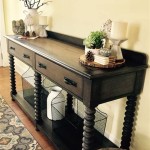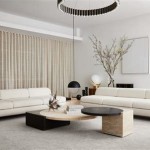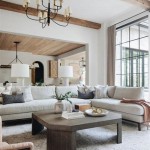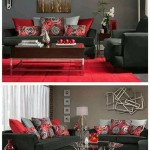Unique Decor Ideas For Home: Elevate Your Living Space
Home decor reflects personal style, creating an environment that fosters comfort, inspiration, and well-being. Moving beyond conventional design choices allows for the creation of spaces that are not only aesthetically pleasing but also uniquely expressive. This article explores distinctive decor ideas for transforming a house into a personalized home.
Embracing Sustainable and Upcycled Elements
Sustainability in home decor has become increasingly prevalent, driven by environmental consciousness and a desire for unique, character-rich pieces. Integrating upcycled and repurposed materials into the design scheme can yield visually striking and eco-friendly results.
One approach involves transforming discarded furniture into statement pieces. An old wooden ladder can be repurposed as a bookshelf, adding rustic charm and vertical storage. Similarly, vintage suitcases can be stacked to form a bedside table, offering both storage and a touch of nostalgia. Reclaimed wood, sourced from old barns or demolition sites, can be used to create accent walls or custom furniture, imparting warmth and texture to the space.
Textiles also offer opportunities for upcycling. Old denim jeans can be sewn together to create a patchwork quilt or cushion covers. Vintage scarves can be repurposed as decorative wall hangings or lampshade covers. These projects not only reduce waste but also add unique character to the decor.
Another sustainable idea is incorporating natural elements found in the local environment. Branches gathered from the backyard can be arranged in a vase as a sculptural centerpiece. Smooth stones can be used as paperweights or decorative accents. These natural touches bring the outdoors in, creating a sense of tranquility and connection to nature.
Sourcing vintage and antique items from flea markets, antique stores, and estate sales is another way to embrace sustainability. These pieces often possess a unique history and character that cannot be replicated by mass-produced items. Repurposing these items breathes new life into them, preventing them from ending up in landfills and adding a touch of timeless elegance to the home.
Furthermore, focusing on durable, high-quality materials that last longer reduces the need for frequent replacements, contributing to a more sustainable lifestyle. Choosing natural fibers for rugs, upholstery, and curtains, such as wool, cotton, or linen, ensures durability and reduces reliance on synthetic materials.
Implementing energy-efficient lighting solutions is another essential aspect of sustainable home decor. LED bulbs consume significantly less energy than traditional incandescent bulbs, reducing energy costs and environmental impact. Natural light should also be maximized by strategically placing mirrors and keeping windows clean.
Incorporating Global and Cultural Influences
Infusing a home with global and cultural influences creates a rich, layered aesthetic that reflects diverse traditions and artistic expressions. Rather than adhering to a single style, blending elements from different cultures results in a unique and captivating interior design.
Textiles are a prominent way to incorporate global influences. Persian rugs, with their intricate patterns and vibrant colors, can anchor a living room and add a touch of opulence. Moroccan poufs, made from leather or embroidered fabric, can serve as versatile seating options. Indian block-printed textiles can be used for curtains, cushions, or wall hangings, adding a vibrant and artistic touch.
Artwork is another powerful medium for cultural expression. African tribal masks, Japanese woodblock prints, or Latin American pottery can be displayed as focal points, reflecting the unique artistic traditions of different regions. Displaying these art pieces not only enhances the aesthetic appeal of the home but also sparks conversations about the cultures they represent.
Furniture styles from around the world can also be integrated into the decor. A Japanese tatami mat can be used as a seating area in a living room, creating a minimalist and tranquil space. A Moroccan-style lantern can add a touch of exoticism to a bedroom. A Scandinavian-inspired dining table can bring a sense of simplicity and functionality to the dining area.
Collecting souvenirs and artifacts from travels provides another opportunity to personalize the home with cultural elements. These items, whether they are handcrafted ceramics from Italy or woven baskets from Southeast Asia, tell stories of personal experiences and add a unique touch to the decor.
The strategic use of color palettes associated with different cultures can further enhance the global aesthetic. Earthy tones and natural materials are often associated with African and Mediterranean styles. Bright, vibrant colors are often characteristic of Indian and Latin American decor. Using these color palettes in combination with other cultural elements can create a cohesive and harmonious design.
When incorporating global influences, it is important to be respectful of the cultures from which these elements originate. Researching the history and significance of the items being displayed ensures that they are presented in a meaningful and appropriate manner. Avoiding cultural appropriation involves understanding and appreciating the context behind these objects and acknowledging their cultural value.
Creating Personalized Gallery Walls and Displays
Gallery walls and personalized displays are effective ways to showcase personal interests, memories, and artistic sensibilities. Moving beyond generic artwork and incorporating unique elements creates a visually engaging and emotionally resonant space. The key to a successful gallery wall lies in thoughtful curation and arrangement.
The foundation of a personalized gallery wall often includes a mix of photographs, prints, and artwork. Family photos, travel snapshots, and meaningful quotes can be combined to create a visual narrative that reflects personal experiences and values. Varying the sizes, shapes, and styles of the frames adds visual interest and prevents the display from looking monotonous.
Beyond traditional framed pieces, other elements can be incorporated to add texture and dimension. Fabric swatches, pressed flowers, vintage postcards, and decorative mirrors can be integrated into the gallery wall, creating a more eclectic and visually dynamic display. These elements add depth and personality, making the gallery wall a true reflection of individual style.
Three-dimensional objects can also be incorporated into the gallery wall. Small shelves can display collected objects, such as vintage cameras, miniature sculptures, or travel souvenirs. These objects add a tangible element to the display, making it more engaging and interactive. Incorporating plants, such as air plants or succulents, can add a touch of greenery and life to the gallery wall.
The arrangement of the elements on the gallery wall is crucial to its overall impact. A symmetrical arrangement, with evenly spaced frames and a balanced composition, creates a formal and orderly look. An asymmetrical arrangement, with varying frame sizes and spacing, creates a more relaxed and eclectic feel. Experimenting with different layouts before committing to a final arrangement is key to achieving a visually pleasing result.
The backdrop of the gallery wall also plays a significant role. A neutral-colored wall provides a clean and uncluttered backdrop that allows the artwork and objects to stand out. A brightly colored or patterned wall can add a bold and dramatic touch, creating a focal point in the room. The color of the wall should complement the colors and styles of the artwork and objects being displayed.
Illumination is another important factor to consider when creating a gallery wall. Strategically placed spotlights or directional lighting can highlight individual pieces and enhance the overall visual impact of the display. Dimmers allow for adjusting the lighting to create different moods and atmospheres.
In addition to gallery walls, personalized displays can be created using shelves, mantles, and other surfaces. Arranging collections of books, ceramics, or other objects in a visually appealing manner can transform these surfaces into personalized showcases. Incorporating plants, candles, and other decorative elements can further enhance the aesthetic appeal of these displays.
Creating a personalized display is an ongoing process. As personal tastes and interests evolve, the elements on display can be updated and rearranged to reflect these changes. Rotating pieces in and out of the display keeps it fresh and engaging, preventing it from becoming stale or predictable.
Ultimately, unique home decor ideas are about self-expression. Embracing individuality and incorporating elements that resonate personally results in a space that is not only visually appealing but also deeply meaningful. These ideas serve as a starting point for creating a home that reflects unique personality and style.

60 Clever Home Decor Ideas That Designers Swear By

10 Unique Home Decor Ideas To Give Your A Personality Makeover Forbes Vetted

100 Home Decor Ideas The Ultimate Inspiration For Interior Designers

13 Creative Home Decor Tips To Refresh Your Interiors

Transforming Spaces With Diy Home Decor Ideas 10 Easy

Free Ebook The Best Home Decor Ideas

Home Décor And Interior Design Ideas For Modern Homes In

Bold Balcony Wall D Cor Ideas To Make A Statement Look Beautiful Homes

Summer Interior Design Trends 2025 7 Decor Ideas That Will Make Your Home Feel Cool And Fresh Hindustan Times

10 Easy Beautiful Home Décor Ideas For Your Qualcon Dreams







